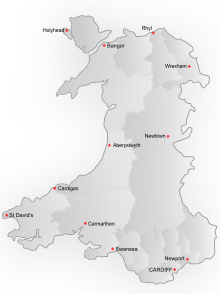In Wales, as in England and Northern Ireland, a town is any settlement which has received a charter of incorporation, more commonly known as a town charter, approved by the monarch[citation needed]. Fifty-five boroughs in Wales were given parliamentary representation in 1536, but the Municipal Corporations Act 1835 recognised only 20 Welsh boroughs[citation needed]. Subsequent urban growth led to the designation of other places as boroughs, including Wrexham, Rhondda, Barry and Merthyr Tydfil, but many other settlements were only granted the status of urban district.[1] The Local Government Act 1972 allows civil parishes in England and Wales to resolve themselves to be town councils.

Cities listed are annotated as "(city)". Until the 16th century, a town was recognised as a city if it had a diocesan cathedral within its limits. The city of St Davids, with a population of about 2,000, received its city status in this way. St Asaph acquired city status in 2012 as part of the Diamond Jubilee of Queen Elizabeth II.[2]
A
editB
editC
editD
editE
editF
editG
editH
editK
editL
editM
editN
editO
editP
editQ
editR
editS
edit- St Asaph (city)
- St Clears
- St David's (city)
- Saltney
- Senghenydd
- Shotton
- Swansea (city)
T
editU
editW
editY
editSee also
editNotes
edit- ^ John Davies; Nigel Jenkins; Menna Baines; Peredur I. Lynch, eds. (2008). The Welsh Academy Encyclopaedia of Wales. Cardiff: University of Wales Press. p. 76. ISBN 978-0-7083-1953-6.
- ^ Beckett, J. V. (2005). City Status in the British Isles, 1830–2002. Ashgate Publishing, Ltd. p. 22. ISBN 9780754650676. Retrieved 31 January 2012.